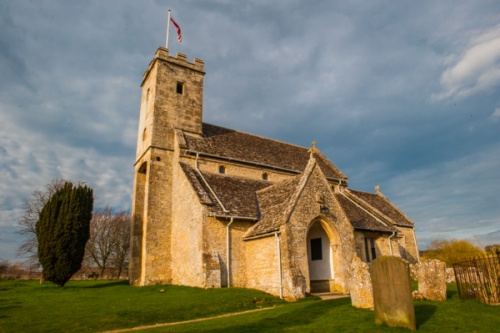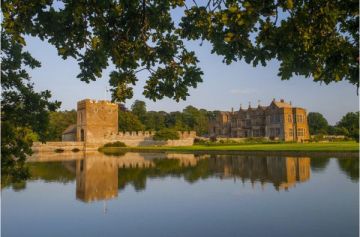
St Mary's was built on a rise of ground overlooking the River Windrush sometime in the 11th or early 12th century. The architecture is a mix of Romanesque and early Gothic, with the addition of a very peculiar west tower added in 1822. The oldest part of the current building is the 12th-century north aisle, while the south aisle is a century later.
In the churchyard to the west of the tower are gravestones to the three Mitford sisters; Nancy, Unity, and Diana. Their parents and fourth sister Pamela are buried at another location in the churchyard, and inside the church is a memorial to their brother, Thomas. The Mitford family lived at nearby Swinbrook House.
There is so much of historic interest in the very simple church interior, most of it in the chancel.
The Fettiplace Monuments
On the south side of the chancel are two sets of monuments to the Fettiplace family, who held the manor of Swinbrook during the 17th century. The family was immensely wealthy and owned estates in 15 counties. No trace now remains of the family manor, but the monuments are a striking reminder of just how powerful and wealthy the family was.
Each tomb shows three male Fettiplaces, recumbent, stacked as if on shelves, one above the other. The earlier tomb is nearest the chancel arch and dates to 1613. The effigies are arranged with the oldest at the bottom and the newest at the top. So you will find the bottom Fettiplace wearing an Elizabethan ruff, but his son, Alexander, wears a high collar, as does his son and heir, William (d. 1562).
This 1613 tomb is relatively simple by comparison to the second monument north of the altar, built in 1686. It is fascinating to see how the style of the memorials changed in the space of 70 years, from undecorated Renaissance sculpture to richly ornamented Carolean fashion. Here, every surface appears to be gilded and painted, and the effect is stunning. This is 17th-century style at its most ornate and grandiose.
On the top is Sir Edmund Fettiplace (d. 1686), and under him Sir John Fettiplace (d. 1672), and on the bottom is John Fettiplace (d. 1657). Again, these are arranged with the oldest at the bottom and newest at the top.




On the south side of the sanctuary, opposite the second Fettiplace monument, is a marble memorial to James Annis, dated 1743. Here the centrepiece is a bust with drapery and cherubs, with a broken pediment surround. Again, the contrast with the second Fettiplace monument is striking.
The Swinbrook Misericords
Set against the south wall of the chancel is a set of 15th-century choir stalls with decoratively carved arms and wonderful misericords. Another stall serves as a seat for the reading desk just inside the chancel arch.
The subject matter of the misericord carvings is wonderfully diverse; there is a woman with her hands on her knees, a grimacing man with a huge nose, a pine cone, and a lion head, among others. Most of the stall arm carvings show human heads, though there is one dragon figure. It is easy to imagine that the woodcarver had specific people in mind when he carved the heads, as each one is different and seems to show a specific character.



On either side of the altar are memorial brasses, one to Anthony Fettiplace (c. 1457-1510) and another to John Croston (d. 1470) and his three wives. Croston is shown in full armour with his feet resting on a greyhound; perhaps a favourite hunting dog? Almost tucked away under the edge of the altar are small figures of Croston children.


brass (d. 1510)
Other items of interest include a very plain 15th-century font, and panes of medieval glass gathered in the east window of the south aisle. On the most westerly nave pillar is a colourful painted and gilded memorial to Joan Goddard (d. 1623).
At the west end of the nave, set on the rear wall, is a memorial to Major Clement Mitford of the Royal Hussars, who was killed in action in Flanders in 1915. Also commemorated in Lord Redesdale of Batsford Park (d. 1916), and the 2nd Lord Redesdale (d. 1958).
Visiting
St Mary's is an absolute delight; the Fettiplace monuments alone are worth a special trip to see. They are among the best examples of 17th-century sculpture in any parish church. The brasses and misericords really do deserve special attention, too, and the village of Swinbrook is just about the prettiest place you could imagine.



About Swinbrook
Address: Pebble Court,
Swinbrook,
Cotswolds,
Oxfordshire,
England, OX18 4DY
Attraction Type: Historic Church
Location: Just above the village green. Limited parking around the green and along the roadside. The church is usually open.
Location
map
OS: SP279121
Photo Credit: David Ross and Britain Express
HERITAGE
 We've 'tagged' this attraction information to help you find related historic attractions and learn more about major time periods mentioned.
We've 'tagged' this attraction information to help you find related historic attractions and learn more about major time periods mentioned.
Historic Time Periods:
Find other attractions tagged with:
12th century (Time Period) - 15th century (Time Period) - 17th century (Time Period) - brass (Historical Reference) - Elizabethan (Architecture) - Medieval (Time Period) -
NEARBY HISTORIC ATTRACTIONS
Heritage Rated from 1- 5 (low to exceptional) on historic interest
Widford, St Oswald's Church - 0.3 miles (Historic Church) ![]()
Asthall, St Nicholas Church - 0.7 miles (Historic Church) ![]()
Burford, St John the Baptist - 1.6 miles (Historic Church) ![]()
Shilton, Holy Rood Church - 2.5 miles (Historic Church) ![]()
Minster Lovell Hall and Dovecote - 2.8 miles (Historic Building) ![]()
Minster Lovell, St Kenelm's Church - 2.8 miles (Historic Church) ![]()
Taynton, St John the Evangelist - 2.9 miles (Historic Church) ![]()
Cotswold Wildlife Park and Manor House - 3.4 miles (Garden) ![]()










